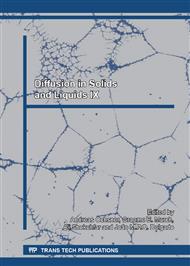p.79
p.84
p.90
p.96
p.101
p.106
p.111
p.116
p.121
Compressive Aggregates of Two-Dimensional Mono-Disperse to Assess Flaw Dissemination
Abstract:
Polystyrene particles of 4 μm in diameter are aggregated as the monolayer clusters rearranged themselves when the compressive forces are applied to the clusters. Oriented structures of the clusters are then examined and characterized the failure mechanisms of two-dimensional (2D) aggregation. Failure mechanisms cause rearrangement of particles within the aggregates. Their flaw locations of each applying force change due to the particle bonding-rebonding themselves. Particles can move either relatively to each other or the small aggregates. Even though, these orientations occur in the small scale and barely significant, disturbed particles gradually accumulate stress. Small aggregates or particles inside the bulk perhaps cannot immediately change the cluster shape, but regularly oriented until reaching to yield. Compression to 2D aggregates can make an existing dislocation and fractures of this aggregated structure. Crack propagation of the dense is possible to proceed dynamically. The clusters collapse until reaching to yield. Two-dimensional structures of compressive aggregated polystyrene are always mechanical instable that increases in propagating rupture. Therefore, the quake will reasonably occur.
Info:
Periodical:
Pages:
101-105
Citation:
Online since:
May 2014
Authors:
Price:
Сopyright:
© 2014 Trans Tech Publications Ltd. All Rights Reserved
Share:
Citation:


